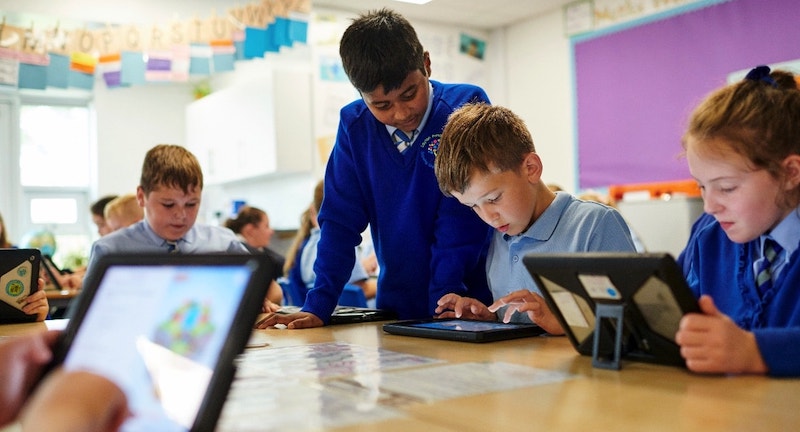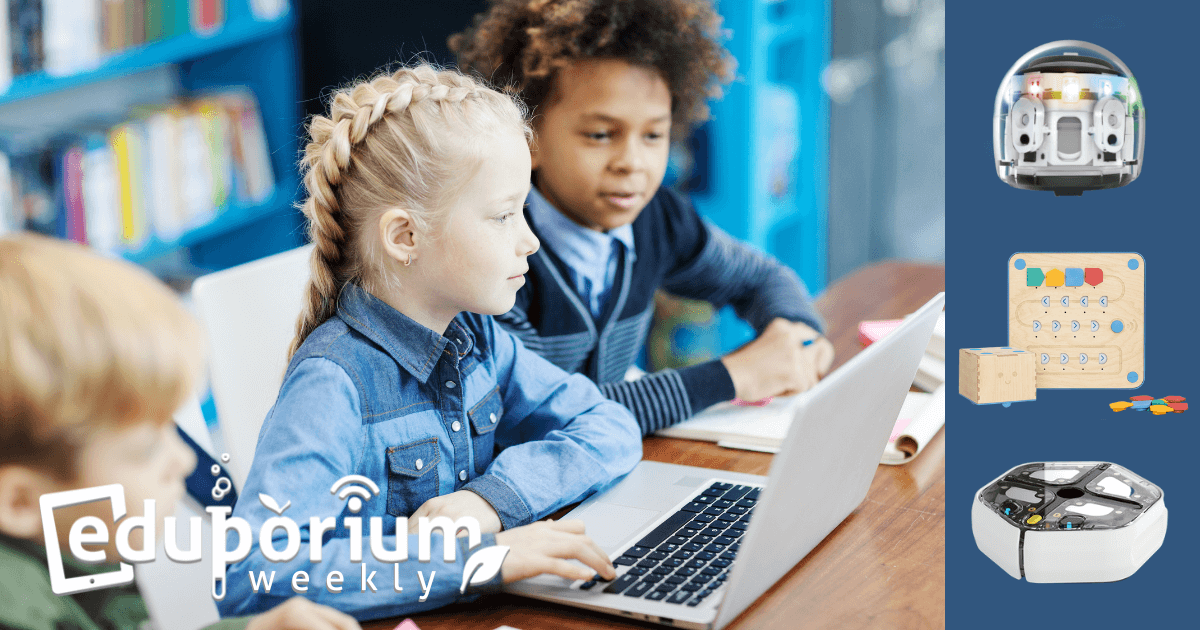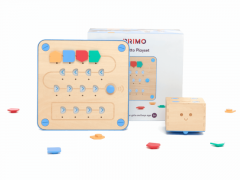As we know, coding skills remain a highly talked about necessity for today's children. Whether or not they end up in a computer science role, so many careers now require at least some coding proficiency—across more industries than ever. Coding for kids doesn't necessarily mean they're writing syntax or implementing their code to resolve world-altering issues. Often, it is as simple as drawing out color codes or connecting simple sets of commands in block coding apps. In any case, coding remains an integral aspect of STEAM development and, with the huge variety of physical and digital coding tools available, it should come as no surprise that there's little restriction on the age children can start programming.
Learning Coding with STEM Tools Designed for Kids
There are two main ways that kids (or older students) can get started with coding: either with physical tools or digital platforms. Most of our expertise involves the physical coding tools, including classroom robotics kits, circuitry solutions, and even programmable drones. Especially as we're now turning the corner on the remote learning era, however, there are many more strictly virtual coding platforms that children can access on devices from almost anywhere—and they're making a huge impact. Starting with physical tools, though, some are accessible for kids as young as five, offering that low barrier to entry, purposeful and exploratory experiences, and opportunities to work on key, age-appropriate skills. At this young age (4-7), kids are not expected to master syntax and other nuances of coding. But it is a good time to develop creativity, critical thinking, and problem-solving skills.
Starting with coding at a young age.
For a long time, we've known the importance of coding education, but not everybody realizes how early it can begin. The fact is that it's possible for educators and parents to introduce students to coding as early as preschool. One of the most popular and effective tools for doing just that is the Cubetto Robot, which is a three-part robotics system that helps ease children into coding. The three parts include the robot itself, a control board, and directional tiles. By placing the tiles into the control board's slots, kids can control all the movements of their robot, including turns. One other element, however, is the board's function section, which corresponds to the function block. When kids add a function tile to a program, their robot completes the tile-based command from that area of the board before resuming additional steps in the main program.
Other Early Ed coding tools for kids.
Of course, this can help children start to recognize the relationship between inputs and outputs, distinguish color-based patterns, and begin understanding the premise of cause and effect. And, they can do all of this without the need for any screen. Also, though learning with the Cubetto helps kids pick up logic, reasoning, and other soft skills, it's not the only programming tool for early education. Once the younger children have some experience, they can try some others as well. Similar to the Cubetto, both the Root Robot and Finch Robot 2.0 have features for pre-readers. They incorporate icon-based coding, so children can create drag-and-drop programs without needing to know how to read. Finally, as for the digital early education coding tools, students can explore Scratch Jr., Coder Kids, or Tynker with teachers.
Coding Skills for Kids to Learn
There are so many elements to coding education—most of which students won't even learn until they have a foundation. As they move through their development, however, there are certain skills teachers can focus on and others that'll essentially come as a byproduct of their experiences. Learning coding techniques can also help students in adjacent problem-solving endeavors, too. When they write code and scheme creative solutions built around it, for example, they're truly thinking like real-world problem solvers. And, with added exposure to coding experiences, they'll build their confidence and a greater love of innovation and problem solving. Plus, like in other classes, coding experiences can help students build the '4 Cs.'
The 4 C's in coding education.
As you may know, the 4 C's are communication, collaboration, critical thinking, and creativity. As you might not fully realize, however, these crucial 21st century skills are actually closely related to coding for kids. Not only will countless children need them to succeed in our highly collaborative, fast-paced, and tech-focused world, they're even commonly associated with coding challenges in the classroom. Whether with physical or digital coding tools, kids have plenty of options to bolster these four skills. Starting with communication, children often feel more comfortable in certain environments as opposed to others. In their coding classes, for example, they may be more willing to ask questions, engage with their peers, or express their thoughts, helping to build key communication skills in the process.
Coding for kids is all about capitalizing.
As for collaboration, many educational coding tools for kids are perfect for this. When they're collaborating, children could gain new perspectives and learn to overcome challenges together. Next, coding experiences help children develop critical thinking skills through problem-based exploration. They can break challenges down piece by piece and attempt to design a solution built around these more manageable chunks. To that end, coding lessons with opportunties for this kind of learning are very valuable. Finally, we have creativity, which is a bit open-ended but still extremely important. Coding and creativity are very closely related with coding providing opportunities for increased involvement and engagement. And, as children pick up new skills, the immediacy with which they can see their value often sparks that creativity.

How to Start with Coding Experiences
When it comes to coding for kids (or even just coding in general), there are so many possibilities for making an impact. While this may seem good at first, it can be overwhelming for both kids and their instructors. It's usually best to really plan out classroom coding lessons, and find ways to highlight key computer science concepts along the way. Depending on the tools you are using, it's sometimes pretty easy to integrate core coding concepts into classroom activities. This, understandably, is a better educational approach than just letting kids play coding games or take part in other activities with less educational value. So, while there is a lot for students to learn, progressing at the proper pace is also important.
Laying the foundation.
To that end, many who've experienced this often suggest that children start out with some more simplistic coding lessons. Teachers can even choose to begin with more of a lecture style at first. With this approach, they can take a couple minutes to introduce students to some of the terms, ideas, and concepts of coding before they even pick up a robot or try writing programs. Though lecture-based lessons are essentially the opposite of the hands-on, interactive experiences children would typically get from classroom CS projects, they can still be valuable—especially to those students who may be brand new to programming. Teachers usually don't need to take too much time explaining things to kids either. Video resources are now almost guaranteed and this valuable content, as you'd expect, helps supplement the hands-on experience.
Different approaches for students of different ages.
If they have coding experience or a basic understanding of how to use coding, introductory lessons might be a bit repetitive for some students. For those in the elementary grades, however, initial activities typically involve block-based coding. This can mean they are utilizing an online coding program or writing programs for a robot. In either case, they're getting that practice and starting to build that foundation. It also provides a good start for understanding some real-life coding applications. On the flip side, for those who are a little older and have some experience, those more intricate and powerful programmable robots are usually their favorites. They help them start to apply their foundational skills and more easily recognize key elements of coding, like commands, variables, and maybe even syntax.
Key Benefits of Coding for Kids
Not only does an early introduction to coding help students out long term, it can provide various immediate benefits, too. We already know that coding and the relevant problem-solving approaches associated with it require regularly increasing layers of creativity. Beyond all that, however, some additional benefits of coding for kids include making learning more fun for them, introducing them to problem-solving techniques geared toward the future, introducing life skills, or adding relevance to learning. Whether they're involved in serious coding or play-based programming, these experiences can do wonders to nurture their natural creativity.
Applying creativity throughout the curriculum.
In terms of creativity, coding will require students to think creatively from start to finish. They won't just feel accomplished once they see one of their programs work successfully. Rather, the nature of coding includes built-in opportunities for students to take pride in creating these programs as well as reworking any failures they have along the way. These constant challenges also help make coding and learning other key subjects more enjoyable for kids. When they code, for example, there's a good deal of math involved—especially as they get older. Plus, once they achieve some success, they are likely to become more enthusiastic and less apprehensive about some of the more challenging aspects of math classes.
Teaching students to be problem solvers.
In addition to creativity, we've certainly seen coding experiences lead to students bolstering their problem-solving skills as well. Since coding is such an abstract endeavor, there could sometimes be various correct solutions. This helps students realize from a young age that designing effective solutions depends more on their creativity and ability to think a few steps ahead rather than simply discovering the 'right answers.' One of the reasons for this is because students are often employing computational thinking strategies. This may mean they're strategically breaking down problems, identifying potential causes, and purposefully working their way towards a legitimate solution—one of the most valuable skills for the real world. And, they could begin learning to develop these abilities in the early grades.

A Roundup of Kids and Coding Today
With all the continued importance of developing coding skills has come all sorts of opportunities for kids to get involved. In many schools, they're taking coding classes or at least have some basic computer science experiences. There are also now those online tools available to them, which sometimes include extensions of what they've done in class or introduce them to entirely new platforms. Beyond this, perhaps some have participated in an afterschool or summer coding program. While the opportunities are available, however, they are still not always equally accessible for every student. It's important for all parents and educators to remember that not every child has the opportunity to practice coding and, while we all typically prefer that they do, there's also no reason to panic.
Key elements of early coding experiences.
Besides helping kids build critical thinking and organization skills, coding experiences can help them learn about persistence and seeing projects through to completion. They are also learning logic when they place blocks of code into programs. Namely, this helps them to see that an input block needs to come before an output block, for example. This eventually translates when they are using more complex coding languages as well—although it will certainly look different. Ideally, when starting out, students should be using digital platforms or physical tools that truly engage them with fun challenges. Plus, finding success early on can help boost their confidence and willingness to take risks.
All the options when introducing coding for kids.
The great thing about coding education is that it's increasingly easy for children to learn—largely because these digital and physical tools are for this precise purpose. Whether they're pre-readers or already in high school, there are plenty of age- and ability-appropriate coding tools. Besides that, kids could also sit in on coding camps or access live online classes, tutorials, and other videos. And, as kids, starting out with icon-based platforms allows them to experience coding in a game-based environment free of intimidation. Then, with block coding, they can build on what they learned and do more when creating their own code. Finally, text-based coding allows students to take everything they've learned and apply it in a more powerful way.
Clearly, coding education now includes many branches, resources, and possibilities. To inquire more about top coding tools for students, including robotics kits or programmable devices, feel free to contact us. For all the latest EdTech, STEAM, and 21st century education news, follow us on Twitter or Instagram. Like us on Facebook, too, or subscribe to our newsletter for all new product announcements and offerings. If you have an idea for an Eduporium Weekly theme, message us on social media or comment below.




